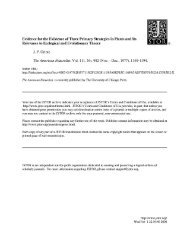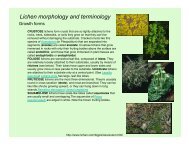Arctic Ecosystems in Russia - Alaska Geobotany Center
Arctic Ecosystems in Russia - Alaska Geobotany Center
Arctic Ecosystems in Russia - Alaska Geobotany Center
Create successful ePaper yourself
Turn your PDF publications into a flip-book with our unique Google optimized e-Paper software.
366 Yu.I. CHERNOV AND N.V. MATVEYEVA<br />
Fig. 16.1. The basic zonal landscapes of the Eurasian <strong>Arctic</strong>. 1, polar desert; 2, arctic tundra subzone; 3, typical tundra subzone;<br />
4, southern (shrub and tussock) tundra subzone; 5, southern limit of the forest tundra.<br />
phic and energetic processes, and cyclicity of the<br />
dynamics <strong>in</strong> biocenoses. Detailed mechanisms of<br />
biocenotic <strong>in</strong>terrelations are also be<strong>in</strong>g studied; for<br />
example, relations <strong>in</strong> the complex of organisms<br />
caus<strong>in</strong>g the fixation of atmospheric nitrogen<br />
(Grun<strong>in</strong>a and Getsen, 1984a,b) or <strong>in</strong> the "phytophage-plant"<br />
system (Bogacheva, 1982; Tishkov,<br />
1985b), the role of trophic relations <strong>in</strong> the formation<br />
of a complex species structure <strong>in</strong> a community<br />
(Khlebosolov, 1986), and various forms of competitive<br />
and symbiotic relations (Litv<strong>in</strong> et al., 1985;<br />
Ovsyanikov and Menyush<strong>in</strong>a, 1986). There have<br />
been some attempts at evaluat<strong>in</strong>g parameters of<br />
the productive process with regard to spatial and<br />
species structure of communities and to gradients<br />
of climatic and microclimatic conditions (Chernov<br />
et al., 1983; Nikonov, 1985; Vilchek, 1986). On the<br />
basis of accumulated data, experiments <strong>in</strong> the<br />
modell<strong>in</strong>g of productive and energetic processes <strong>in</strong><br />
tundra ecosystems have been undertaken (Bazilevich<br />
et al., 1986).<br />
From the viewpo<strong>in</strong>t of modern synecological<br />
concepts, however, the success of synthesiz<strong>in</strong>g all<br />
this <strong>in</strong>formation is still not sufficient with regard to<br />
the peculiarities <strong>in</strong> the dynamics of the arctic<br />
environment and the diversity of the <strong>in</strong>ternal organization<br />
of tundra ecosystems despite their external<br />
monotony (Chernov, 1985). So far, the<br />
production and energetic relations <strong>in</strong> the tundra,<br />
succession processes, the ways <strong>in</strong> which competition<br />
is manifested and its cenotic significance, and<br />
the regulatory role of biocenotic relations and their<br />
<strong>in</strong>terrelation with abiotic factors, as well as other<br />
problems, are not quite clear. Some results on the<br />
primary production and nutrients <strong>in</strong> plants <strong>in</strong><br />
<strong>Russia</strong>n tundra are, however, given <strong>in</strong> Chapter 17<br />
by Bazilevich and Tishkov and Chapter 18 by<br />
Bazilevich (this Volume).<br />
The present account is not to be regarded as a<br />
comprehensive summary or synthesis of the data<br />
accumulated. This is only an attempt at discuss<strong>in</strong>g<br />
those aspects of organization of communities and<br />
ecosystems which, to our m<strong>in</strong>d, seem to be the<br />
most important for the development of synecology<br />
of the tundra. We have chosen the problems for<br />
discussion without tak<strong>in</strong>g <strong>in</strong>to account the degree<br />
of their development. We have proceeded from our<br />
own ideas on the significance of any given phenomenon<br />
<strong>in</strong> the general system of synecological<br />
analysis. Most attention has been given to the most<br />
characteristic tundra landscapes (arctic and typical<br />
tundra subzones, <strong>in</strong> our op<strong>in</strong>ion) which <strong>in</strong> Eurasia<br />
are developed only <strong>in</strong> <strong>Russia</strong>n territory. Much less<br />
attention has been given to landscapes transitional<br />
to the boreal forest belt.<br />
LATITUDINAL DIVISION AND EXTENT OF<br />
POLAR AREAS<br />
The width of the Eurasian tundra belt varies <strong>in</strong><br />
different areas (see Fig. 16.1). On Taymyr, it<br />
extends 600-700 km from south to north. In the<br />
south, it borders the forest tundra and <strong>in</strong> the north<br />
the polar desert. However, <strong>in</strong> other places the<br />
cont<strong>in</strong>ental arctic landscapes are sharply cut by the<br />
coastl<strong>in</strong>e. Thus, west of the Yugorskiy pen<strong>in</strong>sula,<br />
only a narrow belt of the southern type of tundra




